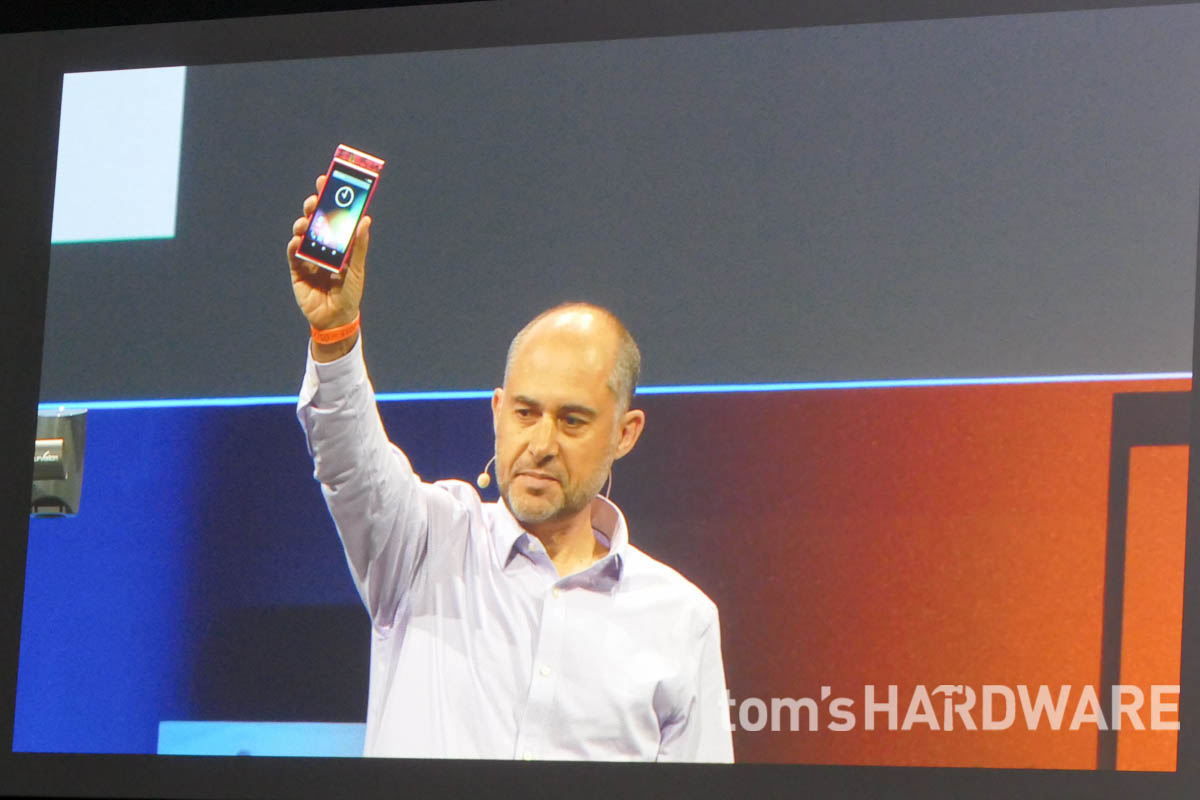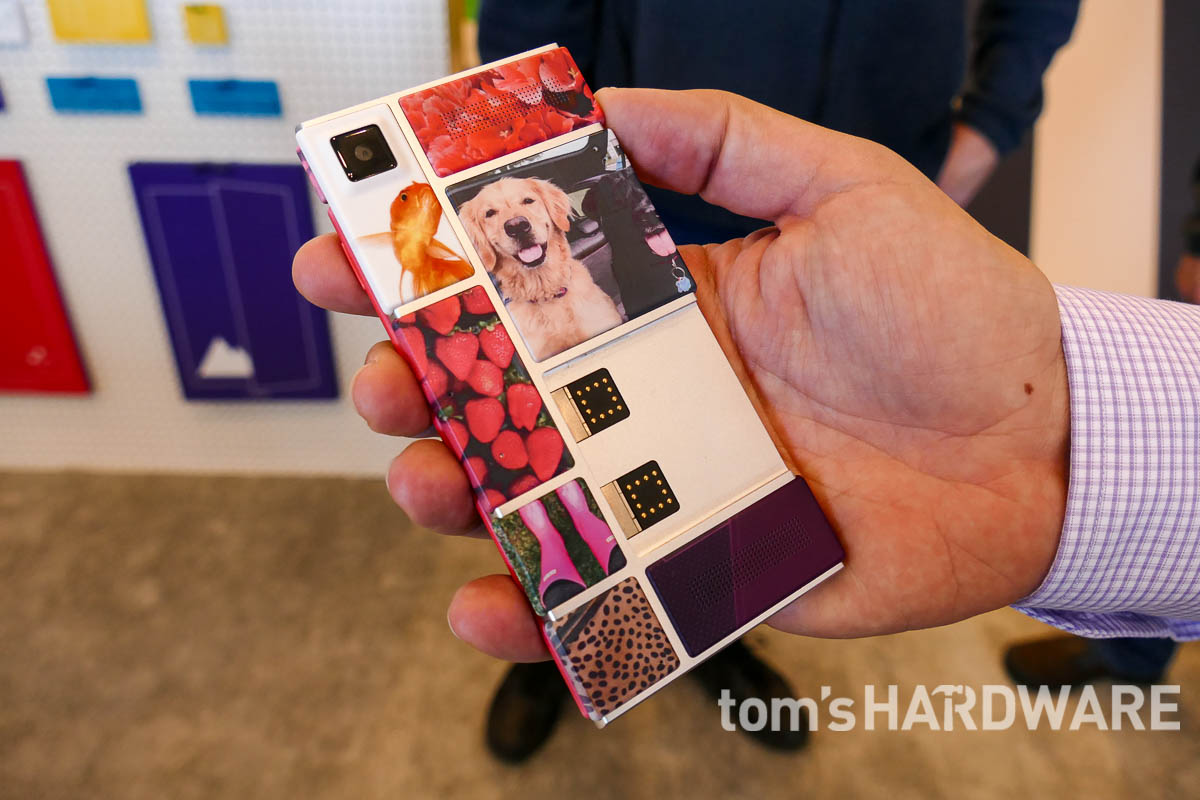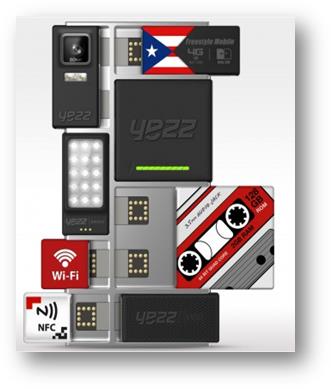Where Are You Going, Project Ara? (Opinion)
Over the last couple of days, the Project Ara Twitter feed has suddenly come to life, as the PR team attached to the project has been trying to keep the world informed of what's happening with the ambitious modular smartphone project. Couched in upbeat, humorous language, the feed has spit out some news that has Ara fans puzzled and concerned. Didn't we just see a fully functioning prototype at Google I/O? What's going on?
Red Flags Waving
As we wrote yesterday, there are several bits of news that have come through that throw up some red flags. In summary:
-Project Ara will no longer use electropermanent magnets to keep the modules attached to the endo-More intelligence is being moved to the core module-The 2015 Puerto Rico pilot project has been scrapped, and a new one somewhere in the U.S. is being planned in its place-The release date for the final consumer version of the phone has been pushed back to sometime in 2016
Magnets, Core Module, Cancelled Plans
We should note at this point that the "failed drop test" hashtag from @ProjectAra, which we and many others wrote about, was meant to be a joke. However, in context, the hashtag accompanied the statement that Ara was moving on from using electropermanent magnets and looking at a "signature experience to attach/detach modules." According to a Google representative, that will include some combination of hardware and software.
Joke or not, it's alarming that the Ara team is suddenly throwing out the way the modules attach to the endo. We were told that the decision was made because the team felt that a solution that consumed less power was preferable, but it's awfully late in the game to be calling such an audible, isn't it?
The decision to move some more intelligence onto the core module is quizzical, too, and frankly more of a dramatic statement. The core module already resembled an SoC; even if that's a space-saving measure, as the tweets suggested, that cuts against the whole point of Project Ara. There was a basic SoC, but the rest of the device's functionality was going to rely on plugged-in modules. If more of that functionality gets baked into the SoC, then...what's special about Ara compared to every other handset out there?
In its tweets, Project Ara also promised better battery life and a better camera. Why it's promising these things is odd, because it would seem that its module maker partners would be the ones in charge of those improvements. (Perhaps the Ara team is making its own modules. Or maybe we're just reading too much into the tweets.)
Get Tom's Hardware's best news and in-depth reviews, straight to your inbox.
Of secondary concern is that these changes could seriously affect module makers. There aren't that many companies we're aware of that are even attempting to make Project Ara modules, and major bumps in the road for the endo's design could mean trouble for those few in development.
With these hardware changes suddenly afoot, it's no wonder that the Puerto Rico pilot was cancelled. But that's just it -- it's not good news that the Ara team is making such dramatic changes that are fundamental to the handset instead of launching a pilot program. At this stage, the group should be putting some finishing touches on the design and build, not rethinking them entirely.
Assurances
A pessimist would be screaming "Vaporware!" at this juncture, but there are reasons for optimism, too. It's unfortunate that Puerto Rico won't pan out, but a Google rep told me that a U.S. pilot is definitely in the works for 2016, pending the selection of a location. (The criteria for selecting a location is not something Google is sharing at this time.)
I was also told that, "We're working closely with module developers to communicate any changes and how that will affect development timelines. We are not aware of any partners that will have to scrap their module plans because of the changes in architecture."
The rep added, "We're confident that we're on the right track and working towards a launch in 2016" and noted that the Ara team is heads-down and hard at work to bring Ara to the people.
It's hard to tell from our limited interactions with those working Project Ara, but either there's a very brave front being put on, or the group truly isn't drenched in flopsweat. Optimism from the Ara camp may not equate to optimism for those of us on the outside, but maybe it's reason to stave off our pessimism. Maybe.
MORE:
- Working Project Ara Phone, Hands On
- Google Taps Yezz For First Project Ara Modules
- Toshiba Outs More Details On Project Ara Modules
- Project Ara To Use Solidenergy's Revolutionary Battery Technology in 2016
- Toshiba And Marvell Unveil Modules For Project Ara
- Project Ara Looks Less Like Vaporware, Launches Hardware For Spiral 2
Seth Colaner is the News Director at Tom's Hardware. Follow him on Twitter @SethColaner. Follow us @tomshardware, on Facebook and on Google+.
Seth Colaner previously served as News Director at Tom's Hardware. He covered technology news, focusing on keyboards, virtual reality, and wearables.
-
jkhoward Why not provide a case with the damn phone to hold the components in like Invisalign braces? Such a stupid decision on their part.Reply -
AcostaJA This is the kind of project that makes no sense and which worries me about Alphabet=Android R&D, an "upgradeable" phone has sense only if you paid the same plus an reasonable prime than the equivalent non-upgradeable, project ARA hardly would meed this goal, as niche device is only attractive for developers interested to try different kind of hardware.Reply
Hardly ARA will deliver an affordable device.
Other things that worry me, is the stability, the industry trend is to include everything on a single chip this saves power but better delivers reliability, as long you add more connectors (specially those high-speed) you add more points succeptible to interference or data loos etc, you add inestability and unreliability.
To me ARA has no sense, has sense only for R&D teams (niche) that need to test their software against the latest harware, sometimes not available on a single device, beyond that, I don't see how ARA could beat a 220$ Moto G, or deliver an flagship device stable and reliable whithout skyrocket price.
I'll kill ARA today. -
LostAlone ReplyThis is the kind of project that makes no sense and which worries me about Alphabet=Android R&D, an "upgradeable" phone has sense only if you paid the same plus an reasonable prime than the equivalent non-upgradeable, project ARA hardly would meed this goal, as niche device is only attractive for developers interested to try different kind of hardware.
Hardly ARA will deliver an affordable device.
Other things that worry me, is the stability, the industry trend is to include everything on a single chip this saves power but better delivers reliability, as long you add more connectors (specially those high-speed) you add more points succeptible to interference or data loos etc, you add inestability and unreliability.
To me ARA has no sense, has sense only for R&D teams (niche) that need to test their software against the latest harware, sometimes not available on a single device, beyond that, I don't see how ARA could beat a 220$ Moto G, or deliver an flagship device stable and reliable whithout skyrocket price.
I'll kill ARA today.
There's some truth to what you say - The idea of Ara only really makes sense if you forsee some reasonably frequent generational leaps in technology in at least some of the sub-modules; a new wireless technology would be the most important, followed by consistent improvements in cameras, but at the moment I don't think either of those are likely.
In the other direction maybe they are more thinking about being hyper affordable with users free to go wireless only or without 4G (or GPS) at a reduced cost. That mid-range market segment I think is much more relevant for reasonably frequent single component upgrades - You could keep up with the latest stuff you want without having to start a new contract or paying through the nose.
Clearly this is always going to be an enthusiast kinda thing but that doesn't mean it's dead on arrival - Remember how the Nexus 5 and 7 were enthusiast devices that became successful because Google priced them very aggressively and I can see them doing something similar here. If it's the right price then there's plenty of consumers who'll give it a go even if they don't really know why they want it (see every watch-device ever made).
If the price is REALLY good then this is exactly the phone you want to get for your kids. Nice big, high def screen but you can skimp on the other specs because kids are kids and they really don't need a $700 flagship to play angry birds and text message and you can upgrade it for them in chunks for birthday and christmas and not by dropping a lot of money in one go.
There's use cases, that's what I'm saying. This all depends on it being priced well, but Google know their market place. If they can't compete on price they aren't going to put it on the market. With the rate of technological advancement now there's little reason to buy an Ara; if you want to upgrade once a year you can get a plan to do that and if you seriously can't wait two months to get the new fastest mobile chip then you have problems. I don't see that being who they are going after and I think we'll see a sub $350 price range with medium specs. That makes sense to me. -
hannibal Well ARA is cool consept. You can change parts like in your desktop computer.Reply
Want to have new faster GPU, just buy new, pull off the old and snap in the new. And so on! This is the good part.
What is bad, well the size of the phone is bigger than a phone with the same specks with normal structure. The Ara most propably is more expensive than a normal phone with the same specs. But as soon as you oly by new module vs a completely new phone, you start to see some savings.
Your screen and CPU are just fine. Buy only new battery and new GPU. You can save a lot of money!
How many of us has bought new CPU lately to desktop? No improvement has happened in that sectors in years. How many have bought new monitor or new GPU or new SSD in the same time?
Modular phone definitely has its merits!
But if it is too big, or if the price difference in the beginning is too deep, I can see some problems. The bigger problem may be that most people in the real world buy the cheapest possible option. And project Ara may not be the answer to that even in the longer run, because Google has some quality standard reservations, that some other companies does not have... So the big audience that goes for the cheapes possible solution is most probably out of market segment for this phone (as any other phone that cost more than 60$ is...)
-
alidan ReplyThis is the kind of project that makes no sense and which worries me about Alphabet=Android R&D, an "upgradeable" phone has sense only if you paid the same plus an reasonable prime than the equivalent non-upgradeable, project ARA hardly would meed this goal, as niche device is only attractive for developers interested to try different kind of hardware.
Hardly ARA will deliver an affordable device.
Other things that worry me, is the stability, the industry trend is to include everything on a single chip this saves power but better delivers reliability, as long you add more connectors (specially those high-speed) you add more points succeptible to interference or data loos etc, you add inestability and unreliability.
To me ARA has no sense, has sense only for R&D teams (niche) that need to test their software against the latest harware, sometimes not available on a single device, beyond that, I don't see how ARA could beat a 220$ Moto G, or deliver an flagship device stable and reliable whithout skyrocket price.
I'll kill ARA today.
There's some truth to what you say - The idea of Ara only really makes sense if you forsee some reasonably frequent generational leaps in technology in at least some of the sub-modules; a new wireless technology would be the most important, followed by consistent improvements in cameras, but at the moment I don't think either of those are likely.
In the other direction maybe they are more thinking about being hyper affordable with users free to go wireless only or without 4G (or GPS) at a reduced cost. That mid-range market segment I think is much more relevant for reasonably frequent single component upgrades - You could keep up with the latest stuff you want without having to start a new contract or paying through the nose.
Clearly this is always going to be an enthusiast kinda thing but that doesn't mean it's dead on arrival - Remember how the Nexus 5 and 7 were enthusiast devices that became successful because Google priced them very aggressively and I can see them doing something similar here. If it's the right price then there's plenty of consumers who'll give it a go even if they don't really know why they want it (see every watch-device ever made).
If the price is REALLY good then this is exactly the phone you want to get for your kids. Nice big, high def screen but you can skimp on the other specs because kids are kids and they really don't need a $700 flagship to play angry birds and text message and you can upgrade it for them in chunks for birthday and christmas and not by dropping a lot of money in one go.
There's use cases, that's what I'm saying. This all depends on it being priced well, but Google know their market place. If they can't compete on price they aren't going to put it on the market. With the rate of technological advancement now there's little reason to buy an Ara; if you want to upgrade once a year you can get a plan to do that and if you seriously can't wait two months to get the new fastest mobile chip then you have problems. I don't see that being who they are going after and I think we'll see a sub $350 price range with medium specs. That makes sense to me.
well look at it this way, you could see the phone as an investment.
do i really need a new screen every phone if mine is already around 300dpi?
do i need a new battery if mine is still working?
do i need a new network card if mine still works or there isn't anything better?
if i dont use it to take pictures all the time do i need the camera upgraded if i think its good enough?
the short answer is no... but you see it all the time that new oses or "upgrades" dont perform as well on older phones, so that cpu/gpu i do need upgraded from time to time, and if i want to own my phone outright and not have to get a new one every few months or years, thats all the better for me. -
razor512 They really don't need to go with this design. A more compatible solution would be to simply avoid BGA components, and move to socketed components instead.It will make the phones probably 1 mm thicker, but it will allow for standard designs to become upgradable, e.g.popping out the SOC, and installing a faster one, or replacing the RAM, or adding more flash storage.Reply
As long as the components are pin compatible, upgrades will be relatively simple.
For almost all smartphones, the camera module is already removable.
Simply use sockets for the SOC, RAM, Flash, Wireless radio chipset, and audio components.
Then even without companies taking a specific interest, users can take their devices apart, do a search on the model number of the chip they want to upgrade, and then look through the datasheet (a design like this will mean that the company will not go out of their way to make the device non user serviceable). Many pin compatible chips will list multiple versions on the same datasheet. With a small amount of work, a user can then source the bare component and do the upgrade them self. or if needed, the company can provide a curated list of compatible components.
The issue with Project Ara, is that it leads to a lot of extra complexity and redundancy since they are making multiple modules fit a standardized bus. Think of it like when AGP videocards were dying out, but there was still some demand for higher end PCI express cards for AGP systems. You would notice that all of those higher end AGP cards, has a special chip that got insanely hot, it was essentially adapting and handling the translation needed for a PCI express card to work with AGP
You will end up with that for Project Ara, which will eat into efficiency of the device.
Unless they gain the mjority of the combined smartphone market,they will be unlikely to get components designed specifically for heir interface, instead you will have companies doing stuff like sourcing a MOC 100 BGA transceiver and then adding like 50+ other supporting passive and active components to make it work with the custom connector interface of the phone.
While it will be more convenient for the end user in terms of customizing their device. it will cost more to get the performance they want. The device will be heavier, and there will be less room for the battery.
A to sockets with the standard layouts, means that phones can keep their stacked design (screen on top, PCB in the middle, removable battery on the bottom), but allow the user to simply access the PCB in an easy manner, and then swap components. -
sisman2000 Meanwhile top tier phone maker Samsung is moving in a different direction without removable battery and memory, not seeing the market need for Ara-like device.Reply -
AcostaJA ReplyMeanwhile top tier phone maker Samsung is moving in a different direction without removable battery and memory, not seeing the market need for Ara-like device.
The problem with Samsung is that they believes they are selling phones to iPhone owners...
Anyway, while Samsung is excessive and out of focus about battery and SD memory, the fact is common people (not Geeks and Geek-wannabe) is more often to never update nor upgrade theis PCs, some reasoning is that Upgrade dont provides you and New Device, just one patched with some new tech, ussually not in optimal setup, while selling the current device and purchasing an entirely new one actually gives the top.
Android phones are dropping cost fast, today the Motorola Moto G 2015 is as capable as the Galaxy S4 (less than 2yr), and not allways an update is really an upgrade, this apply to Note 4 owners that dont wanna update to the Note 5 since seems an inferior device to many of them.
Upgradability also is an tricky promise, hopefully most devices are now 64 bits, but imagine you purchased an ARA phone a year ago and realize now you cant upgrade it since its an 32 bits core not compatible with new 64 bit peripherals ?...
ARA's upgradability is too overated and only very few actually are interested on this. -
eriko Quote: If the price is REALLY good then.....Reply
I once heard someone say, there is no such thing as bad products, just bad prices. -
Quixit The current trend for less expensive handsets and the slowdown of hardware development have sorta blunted the point that launched Ara in the first place. If you can own a single handset for 3-5 years without feeling you need to replace it you don't really need an upgradeable phone. Most phones break or wear out within 5 years anyway, unless Ara is built like a tank I can't see one lasting much longer than a normal phone, although it would make it easier to repair.Reply
I'm still interested in the idea, it just seems like it may not have the mass appeal they expected when it does launch. If a $130 Xiaomi phone is fine for most people, it will be hard to sell an Ara phone that's even close to competitive with that. If you don't think that type of phone really exists read this http://www.gearbest.com/cell-phones/pp_204055.html (I do not endorse this store or product, it's just interesting what you can get for such a crazy low price).



